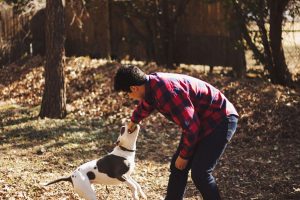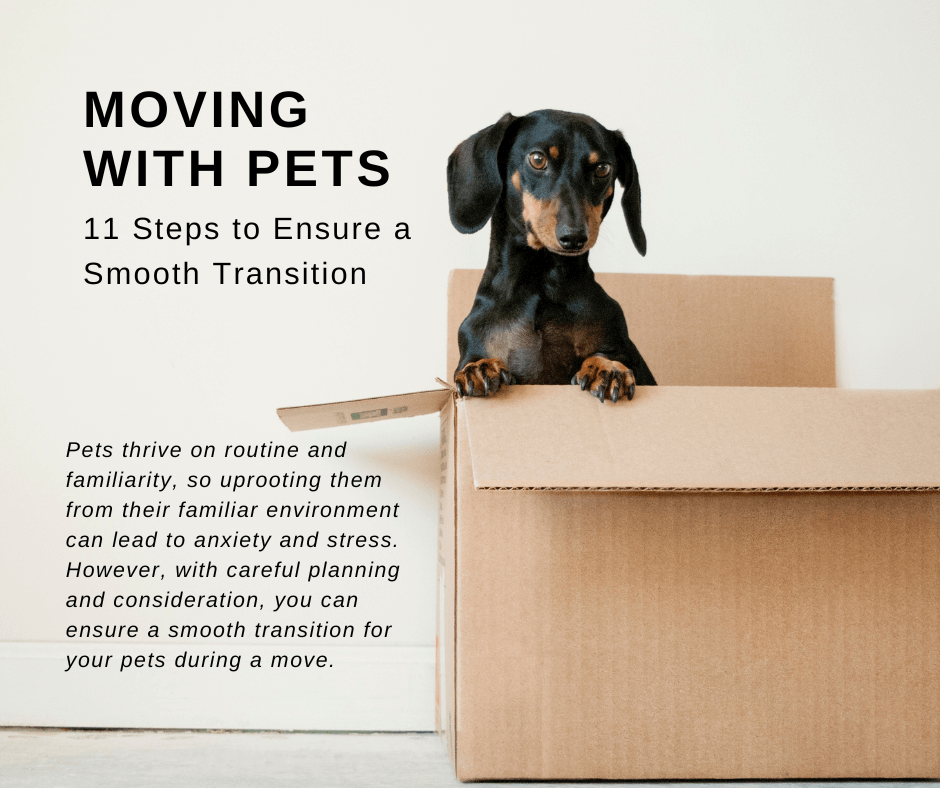Moving to a new home can be both exciting and stressful for humans, but it can be even more challenging for our furry companions. Pets thrive on routine and familiarity, so uprooting them from their familiar environment can lead to anxiety and stress. However, with careful planning and consideration, you can ensure a smooth transition for your pets during a move. In this article, we’ll address common questions, provide answers, and offer facts to help you navigate this process successfully.
Preparing Your Pet for the Move
Q: How can I prepare my pet for the upcoming move? 
A: Preparation is key to minimising stress for your pet. Commence by upholding their routine to the best of your ability. Gradually introduce them to moving supplies like boxes and suitcases, so they become accustomed to the changing environment. Ensure they have proper identification with updated contact information, in case they get lost during the move.
Fact: Animals, particularly cats and dogs, are highly sensitive to changes in their environment. Their sense of smell is much stronger than ours, allowing them to detect even subtle changes. This is why preparing them gradually for a move is important.
Familiarising Your Pet with the New Home
Q: Should I visit the new home with my pet before moving?
A: Whenever possible, it’s a good idea to take your pet to the new home before moving day. This will help them become familiar with the new smells and surroundings. If it’s not feasible to visit in person, you can bring back an item that smells like the new home and let your pet explore and sniff it.
Fact: Cats are particularly territorial animals. They become attached to the territory they consider their own, which is why introducing them to the new space before moving can help them adjust better.
Handling Moving Day
Q: How should I handle my pet on moving day?
A: On moving day, it’s best to keep your pet in a quiet and secure area, away from the hustle and bustle. This could be a room with their familiar belongings, where they won’t get stressed by the noise and activity. Make sure they have food, water, and any necessary medications during this time.
Fact: Dogs can be especially sensitive to the emotions of their owners. If you’re feeling stressed or anxious on moving day, your dog might pick up on these emotions. Keeping them in a calm environment can help ease their anxiety as well.
Safe Travel for Your Pet
Q: How should I transport my pet to the new home? 
A: For small pets, like cats and small dogs, a secure and well-ventilated carrier is essential. Make sure the carrier is familiar to them by placing their bedding or a piece of clothing with your scent inside. For larger dogs, it’s best to use a harness and leash for added safety during travel.
Fact: It’s important to ensure your pet’s safety while travelling. Before air travel, make sure you acquaint yourself with the airline’s pet guidelines and invest in a carrier approved by the airline. Check this article by humanesociety.org to learn more.
Settling into the New Home
Q: How can I help my pet settle into the new home?
A: Once you’ve arrived at your new home, give your pet plenty of time to explore and get comfortable with their new surroundings. Create a designated space with their bed, toys, and belongings they recognise. Stick to their routine as closely as possible, including feeding times and walks.
Fact: Scent plays a big role in helping pets feel secure. Rubbing a soft cloth on your pet’s face and then rubbing it around the new home can help spread their scent and make the environment feel more familiar.
Building a Relationship with a New Veterinarian
Q: When should I establish a new relationship with a veterinarian? 
A: If you’re moving to a new area, it’s essential to establish a relationship with a local veterinarian as soon as possible. Ask for recommendations from neighbours or research online to find a reputable vet who can provide your pet with the care they need.
Fact: Certain areas may have different health risks for pets, such as specific tick or mosquito-borne diseases. A local veterinarian will be well-versed in these risks and can guide you on preventive measures.
Additional Steps to Reduce Pet Stress
Q: What are some additional steps I can take to reduce my pet’s stress during the move?
A: In addition to the strategies mentioned earlier, you can use pheromone products like diffusers or sprays designed to calm pets. These products release synthetic versions of comforting pheromones, which can help reduce anxiety in cats and dogs. Also, maintain your pet’s exercise routine as much as possible to help them release pent-up energy and stay relaxed.
Fact: Pheromone products mimic the natural chemical signals that animals use to communicate with each other. For example, Feliway is a synthetic feline facial pheromone that helps calm cats in stressful situations.
Adapting to the Outdoor Environment
Q: How can I help my pet adjust to their new outdoor environment? 
A: If you’re moving to a new house with a yard, supervise your pet’s outdoor time initially. Make sure the yard is secure and free of potential hazards. Gradually increase the amount of time your pet spends outdoors, allowing them to explore and become familiar with their new surroundings. For indoor cats, consider setting up a safe and stimulating space near a window.
Fact: Cats are naturally curious and territorial. When introducing them to a new outdoor environment, use a harness and leash to prevent them from getting overwhelmed or running away. Outdoor exploration should be gradual and controlled.
Recognising Signs of Stress
Q: What signs should I look for to determine if my pet is stressed or anxious?
A: Pets may exhibit various signs of stress, including excessive grooming, loss of appetite, hiding, restlessness, and changes in behaviour. Monitor your pet closely during the moving process and in the days following the move. If you notice any concerning behaviours, consult your veterinarian for guidance on managing their stress.
Fact: Dogs may show stress by excessive panting, yawning, or pacing. Cats may hide, avoid interactions, or become more vocal. However, remember that some changes in behaviour are normal as pets adjust to a new environment.
Moving with Exotic Pets or Birds
Q: Are there any specific considerations for moving with exotic pets or birds? 
A: Exotic pets like reptiles, birds, and small mammals have specialised habitat requirements. Research the specific needs of your exotic pet and consult a veterinarian experienced in exotic animal care. Maintain their habitat temperature and humidity levels during transportation, and ensure they are securely housed to prevent escape.
Fact: Birds, in particular, can be sensitive to changes in routine and environment. Covering their cage partially during travel can help reduce stress. Ensure that the cage is well-ventilated and that the bird cannot get caught in any moving parts.
The Role of Patience and Positive Reinforcement
Q: What is the role of patience and positive reinforcement in helping pets adjust?
A: Patience is vital when moving with pets. Understand that it might take time for your furry friend to feel comfortable in the new environment. Use positive reinforcement techniques to reward good behaviour and help them associate positive experiences with the new home. This can include treats, affection, and praise.
Fact: Dogs, in particular, thrive on positive reinforcement. Reward-based training methods can help them build confidence and establish a positive connection with the new space.
Conclusion
Moving with pets necessitates empathy, planning, and understanding their needs. Prioritising your pet’s well-being is crucial as you navigate this journey together. Gradual acclimatisation, introducing them to the new home, and providing a secure space on moving day lay the groundwork for a seamless transition. Tailoring your approach to their sensitivities, such as their heightened sense of smell and territorial instincts, is essential. Consistency, familiar scents, and positive associations with the new environment offer stability during change.
While challenges arise, the benefits of a smooth transition are immense. Consultation with a local vet, pheromone products, and safe outdoor zones affirm your commitment to their comfort. Ultimately, your patience and proactive care shape their adjustment. Vigilantly observe their behaviour, promptly addressing stress signs. Your support fosters their adaptation and flourishing in the new home. This journey underscores the special bond shared with pets, reflecting your dedication to their joy and well-being. It highlights the profound relationship between humans and animals, founded on love and a shared journey through life’s enriching experiences.
See also our FAQs and Tips
Chat with our team 📞1300 420 958


